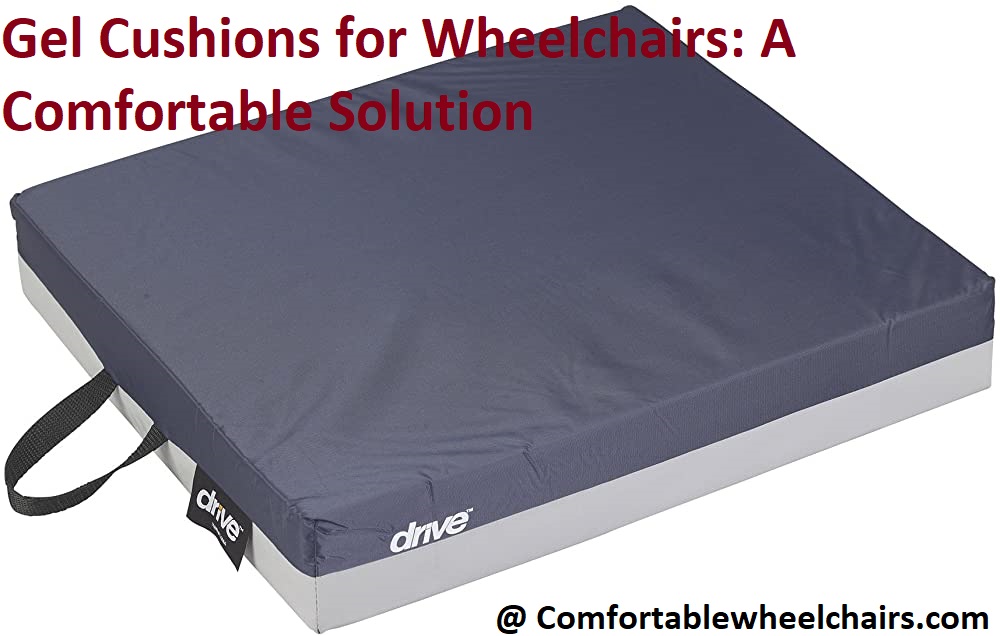Are you looking for a comfortable wheelchair solution for your daily travels?
Gel cushions can be the answer you’re looking for! This complete guide will help you better understand why gel cushions are a great fit and how to choose the best one for your needs.

This guide provides an overview of the different types of gel cushions available for use in wheelchairs and other mobility aids, as well as information to help you make an informed decision about which cushion is right for you. Wheelchair cushions are an important aid for those with limited mobility, and can provide comfort, support and stability while using a wheelchair. Choosing a cushion that takes into account personal needs and preferences can make a huge difference in the way it feels to be seated in a wheelchair.
The three main types of wheelchair cushion materials – foam, air, and gel – each have their own benefits and drawbacks that must be carefully considered before making a purchase. This guide will discuss the pros and cons of each type, as well as factors such as size, portability and maintenance. We’ll also discuss some tips for assessing which type of cushion is best for your individual needs. By the end of this guide, you should have enough information to make an educated decision on which type of cushion will be most beneficial for your specific situation.
Explanation of what gel cushions for wheelchairs are
Gel cushions for wheelchairs provide a comfortable and anatomically supportive surface for the user of the wheelchair. This type of cushion is designed to evenly distribute the user’s weight across its entire surface, rather than focusing it in one area. The layers of gel in the cushion interact with each other, forming an ergonomic cushion that maximizes pressure-relief while also providing superior stability and positioning.
Gel cushions are also beneficial because they are adjustable, allowing users to customize their cushion and create a more tailored fit to maximize comfort and safety. Gel cushions for wheelchairs can provide users with an improved posture, eliminating potential frustration and fatigue associated with sitting in a wheelchair too long. Additionally, many gel cushions come with a built-in base that helps protect the user from slipping forward or backward and helps keep them secure in their wheelchair seat.
Importance of using gel cushions for wheelchair users
Gel cushions for wheelchairs are often recommended by medical professionals for individuals who spend an extended amount of time in their chairs. These cushions reduce the chance of developing pressure sores, which are an all-too-common problem among wheelchair users. Additionally, they help improve posture and promote proper alignment while also helping to maintain soft, natural curves to relieve stress on the spine and muscles.
Gel cushions provide superior pressure relief in comparison to traditional foam cushions by dispersing the user’s body weight equally over a larger area. This helps to reduce localized points of pressure that can cause pain or create skin irritation while sitting in a chair over time. In addition, gel helps improve blood circulation around areas of high pressure. With improved circulation comes increased comfort levels as well as better mobility throughout the chair due to decreased friction with every movement made in a wheelchair.
Benefits of Gel Cushions
Gel cushions for wheelchairs can provide a number of benefits to individuals with physical and mobility challenges. These cushions work to address many issues that those with limited mobility may face when sitting for any length of time in a wheelchair. Some common benefits of gel cushions include:
-Reduced Pressure Points: Gel cushioning can help to reduce the amount of pressure experienced in certain areas where contact is made between the body and the seat back or sides, while also distributing pressure more evenly over a larger area. With regular cushioning, there is an increased risk that pressure points may occur in localized areas due to uneven weight distribution or potential misalignment between the wheelchair user’s body and their seating surface.
-Improved Comfort: Not only is comfort improved thanks to better pressure distribution, but via more consistent temperature levels throughout the seating surface as well; the viscoelastic properties of gel cushioning helps to reduce heat build-up beneath its contact surface thanks to its open cell foam technology which promotes greater air flow – allowing heat energy produced by the user’s body to dissipate quickly instead of becoming trapped inside traditional cushions. This can be particularly beneficial for those who experience skin problems due to wetness or poor ventilation caused by impermeable seating materials such as foam rubber or vinyl.
-Enhanced Safety: Padding consisting solely of foam cushioning does not always provide adequate support and stability for individuals who are at risk for skin breakdown issues due recent surgery, obesity, age related factors or existing medical conditions such as diabetes which can cause reduced sensation in certain areas. Gel cushioning helps wheelchair users maintain a healthy sitting position since it reduces their risks against sliding forward while eliminating possible sliding backwards – both of which could increase their chances toward sustaining an injury from sudden falls caused by improper posture placement on thin foams without firm structural support.
Improved Comfort
Gel cushions provide wheelchair users with improved comfort, allowing them to enjoy activities without feeling sore or fatigued. Gel cushions perform better than foam or air filled cushions when it comes to supporting the body in the same position for extended periods of time, reducing pressure points and movement-related soft tissue bunching which can lead to discomfort and fatigue.

In addition, gel cushions provide better heat distribution, creating a more comfortable temperature level and helping to avoid hotspots from forming due to disproportionately high body temperatures in certain areas. With the use of these gel cushions, wheelchair users are able to enjoy extended periods of activity without worrying about discomfort.
Pressure Relief
Pressure relief is one of the most important element when it comes to selecting a cushion for a wheelchair user. It is essential to choose the right balance between firm enough support and soft cushioning to prevent pressure sores. Types of cushions offering pressure relief can be broadly defined into two, foam and gel.
Foam Cushions are made from one or more layers of polyurethane foam which is typically pressed, cut or moulded down to deliver improved weight distribution and shock absorption. They are available in several shapes, sizes and contours providing good stability and reducing shear movement. Different densities enable cushions tailored to individual requirements with softer or firmer foam used according to body weight and other medical needs.
Gel Cushion are typically constructed using visco-elastic memory foam as a base layer topped with a thin layer of gel. This top layer offers some extra protection against tissue breakdown given its viscous— plastic properties which helps redistributes weight over the entire surface area alleviating pressure points while allowing air circulation beneath the user’s body, thus cooling them down faster than other materials. Both Gel Cushions provide excellent pressure management with minimal bottoming out however some protrusion may occur if postural changes occur quickly during transfers in either direction though overall they offer superior comfort even after multiple hours spent in a seated position whilst promoting correct posture endurance and adaptability especially compared against conventional foam constructions.
Enhanced Stability
Gel wheelchair cushions not only provide comfort but also enhanced stability. Studies have demonstrated that moderate to high-risk patients benefit greatly from the use of gel wheelchair cushions. By distributing body weight evenly, these cushions help to reduce the risk of very uncomfortable pressure points from forming and this can be especially beneficial for people who are required to spend more time seated for their daily activities.
Gel cushions also offer postural support and promote proper blood flow and circulation in the affected area. This helps reduce skin breakdown as well as burn risk since pressure is kept off vulnerable areas of the skin for extended periods of time. Additionally, proper posture decreases lower back muscle strain, helping you feel more comfortable at work or with daily leisure activities such as reading or watching television.
For individuals that are limited in side to side movement due to physical constraints, lateral stability offered by gel wheelchair cushions can prove invaluable. Many users find that they can now sit up straighter without having the constant fight with gravitational forces created by muscle contractures or spasticity if present in certain neurological diagnoses such as cerebral palsy (CP).
Finally, these cushions offer a breathable soft surface that absorbs perspiration keeping your skin cool while helping improve air circulation thus reducing potential sweating while seated throughout all seasons, particularly during warmer months; a feature which can make all the difference when trying to remain comfortable at work or school particularly during long hours of active engagement with studies or tasks.
Reduced Risk of Skin Injuries
For those who spend many hours in a wheelchair, pressure wounds can be a significant risk. Gel cushions are designed to help protect skin from excessive pressure, which can be caused by friction and shear forces. This type of cushion uses a viscous gel inner core to help distribute pressure evenly across the user’s body. The gel remains soft and malleable, yet firm enough to provide comfort and support. The outer layer is usually made of urethane foam or microfiber, both of which are excellent at conforming to the shape of your body while providing cushioning support needed through everyday use.
Additionally, most gel cushions also feature perforations within the pad itself so that air can circulate freely throughout it and reduce heat build-up in particular areas that may cause discomfort or irritation over time. Along with providing maximum comfort and support, this helps greatly reduce the risk of skin injuries such as sores or abrasions from forming on those in wheelchairs for long periods of time.
III. How to Choose the Right Gel Cushion
Choosing the right gel cushion is an important part of ensuring your comfort and safety when using a wheelchair. The correct selection can help reduce stress on pressure points, support good posture, and provide shock absorption for uneven terrain. Here are some factors to consider when selecting a gel cushion:
Size – Gel cushions come in various sizes to suit different wheelchairs. The cushion should fit snugly in the chair without leaving gaps between the edges and the frame. Measure your wheelchair’s seating area before you buy to ensure a perfect fit.
Thickness – Generally, thicker cushions offer more support, but be careful that it isn’t too thick because this can cause you to sink down into the seat and impair balance or comfort.
Foam layer – Depending on your requirements, you may want to choose a foam layer beneath the gel cushion for additional support and comfort. If so, make sure that it is breathable foam with adequate ventilation for breathability.
Anti-slip coating– Consider choosing a gel cushion with an anti-slip coating that helps keep it securely in place as you move around in your wheelchair throughout the day.
Cover – Choose a durable removable cover that can be easily washed or replaced if necessary, such as those made from waterproof fabrics or synthetic leather materials. Ensure that the cover has appropriate holes or cutouts so air can flow easily through it and over the skin of users during warm weather conditions to maintain optimal comfort levels.
Factors to consider when choosing a gel cushion
When choosing a gel cushion for a wheelchair, there are several factors to consider. Comfort and pressure relief are vital in achieving an optimal seating experience. The right gel cushion will depend on the individual’s postural needs as well as lifestyle demands such as spending time outdoors or travel. It is important to select the correct size and shape of cushion for the user’s body and needs.

The type of material used for the surface layer will impact how comfortable you feel in your wheelchair. A variety of fabrics are available, such as Herculite II and Vinyl with PU coating; these materials should be waterproof and easy to clean so that the cushion offers maximum protection, keeping it hygienic over prolonged use. It is also essential that the filling inside allows air movement so persons can stay cool during challenging situations like hot climates or long periods of sitting without feeling uncomfortable or constantly shifting around – this applies especially to users who tend to build up heat quickly or have sensitive skin and/or pressure ulcers.
The firmness of the gel cushion should provide adequate support while still allowing movement; giving way slightly at appropriate moments when sitting but remaining stiff enough to keep users in their desired position within their seat base unit for extended periods at a time. The contours of a wheelchair cushions should fit anatomically around your body curves to improve user comfort levels, help maintain correct posture throughout each day and reduce chances of developing muscle strain from incorrect positioning or pain resulting from direct pressure on certain areas like bony prominences (hips for example).
Understanding different cushion materials
Depending on the user’s needs and medical condition, there are a variety of cushion materials from which to choose. To help make an informed decision, understanding the features and benefits of each material is important.
Foam Cushions: Foam cushions are made from high-resilience foam and provide both comfort and support. They typically come with several layers that can be adjusted depending on the pressure required to fit the user’s individual needs. Additionally, these types of cushions commonly come with a water-resistant cover to help reduce any skin moisture allergies.
Gel Cushions: Gel cushions are made with a 100% medical-grade gel bladder cushioning system that evenly distributes pressure and weight across the surface while conforming to form around wheels and body contours to reduce areas of peak pressure build up. These type of cushions also have countless medical benefits such as reducing friction against skin, promoting better circulation, helping prevent sores, preserving essential tactile response for accurate positioning in chairs for balance control or to hold onto arms or other handles for support stabilization. The gel material also does not heat up during extended periods of use like foam does because it dissipates heat quickly due to its high thermal capacity rating.
Air Cushion: An air cushion is constructed from multiple air cells combined with synthetic fibers placed inside breathable fabric sleeves or covers which greatly decreases skin temperatures during long time usages. This type of cushion is particularly effective in distributing pressure evenly across any surface aiding circulation while reducing frictional forces between body parts and surfaces even further than gel cushions can do alone. Air cushions also conform to natural body curves providing additional comfort over longer durations than any other type cushion on the market today.
Conclusion
Overall, gel cushions provide a comfortable and effective solution to the challenges of wheelchair mobility. With their excellent combination of contouring, breathability and support, they offer optimal relief from skin sores, pressure ulcers, and discomfort. Gel cushions can also reduce static pressure to help improve circulation. Additionally, they are lightweight, creating a pleasant and ergonomic sensation, while providing lasting reliability.
Whether your time in a wheelchair is temporary or more permanent due to disability or medical condition, gel cushion products can be a beneficial tool for comfort.
When considering the purchase of a gel cushion product for your wheelchair it is important to factor in quality ratings from independent reviewers as well as your desired level of support and comfort. To find the cushion that will work best for you it’s important to talk with your healthcare professionals about which type is best suited for your particular needs and lifestyle. With proper care and maintenance, gel cushion products can help make wheelchair mobility enjoyable and easy for many users who rely on them daily.
FAQs
What are the benefits of gel seat cushion?
Gel seat cushions can provide pressure relief, distribute weight more evenly, reduce vibrations, and offer a cooling effect.
How can I make my wheelchair more comfortable?
You can make your wheelchair more comfortable by adding a cushion, adjusting the seat height, replacing worn parts, and ensuring the wheelchair fits your body properly.
Is air or gel wheelchair cushion better?
Both air and gel wheelchair cushions have their advantages and disadvantages, and the best option depends on individual needs and preferences.
What is the best kind of cushion for a wheelchair?
The best kind of cushion for a wheelchair depends on factors such as the user’s needs, level of activity, and budget. Gel and foam cushions are popular options.
Are gel seats comfortable?
Gel seats can be comfortable for some users, as they provide a soft and cushioned seating surface.
What is the difference between gel and foam cushions?
Gel cushions use a gel material to distribute weight and pressure, while foam cushions use a foam material to provide support and comfort.
Which gel seat cushion is best?
The best gel seat cushion depends on individual needs and preferences. Some popular options include the ROHO MOSAIC, Drive Medical Gel “E” 3″ Wheelchair Cushion, and FOMI Premium All Gel Orthopedic Seat Cushion.
What is the purpose of the soft gel-like cushion?
The purpose of a soft gel-like cushion is to provide comfort and reduce pressure on the body while sitting.
How long do gel cushions last?
The lifespan of gel cushions can vary, but they typically last between 1-3 years with proper use and maintenance.
What makes a comfortable seat cushion?
A comfortable seat cushion should provide support, distribute weight evenly, reduce pressure, and be made from high-quality materials.


